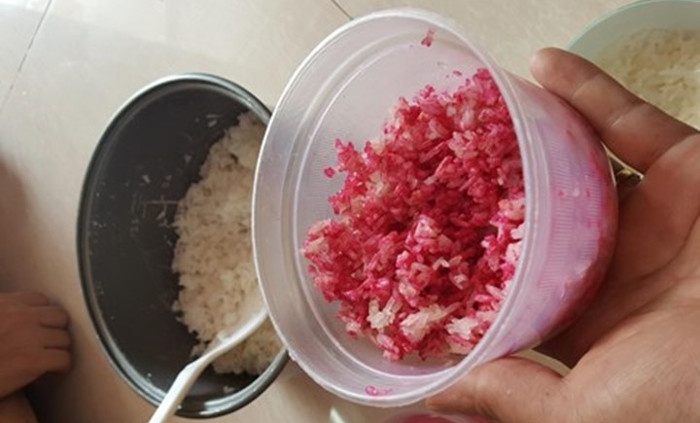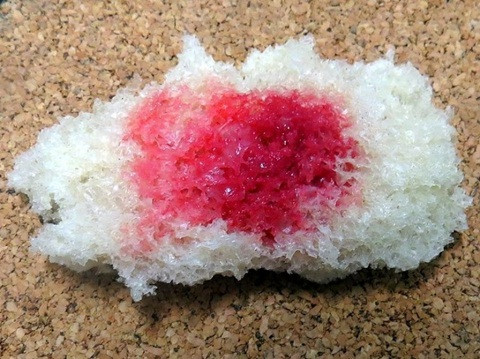Why does rice for overnight change red?
The results of the evaluation of cooked rice samples into rice are said to be discolored when left overnight, authorities do not detect foreign substances, do not change colors, the rice is still flexible, soft, natural white .
Previously Mr. Tran Quang Thai in Binh Chanh District, Ho Chi Minh City, reflected the discovery of rice in the pot changed from white to red like blood after leaving overnight. He bought rice near Binh Chanh market. Neighbors found it strange to pick up some rice to cook, so it would be similar to the next day.

Overnight rice turns itself red, according to people's reflection.(Photo: University).
Suspecting that the rice was soaked with chemicals, Mr. Thai put the remaining rice to expertise at the Center for Standards and Quality 3. The results were noted: The appearance of long grain rice, ivory white, slightly transparent . Technicians using analytical methods using spectroscopic spectroscopy (IR) and fluorescence spectroscopy (XRF) found that rice samples are mainly carbohydrate, protein, and no other foreign substances were detected. All cooked rice is soft, pliable, white, even overnight at room temperature or in a refrigerator, the rice does not change color.
The representative of the assessment center concluded "The above sample does not contain strange chemicals, there is no discoloration phenomenon compared to the natural color of rice and rice after being cooked". However, the amount of samples is too small, not enough to test other microbiological and physicochemical criteria.
Based on the above analysis results, Dr. Phan The Dong, lecturer of Faculty of Science and Technology, Hoa Sen University, Ho Chi Minh City, said that the phenomenon of rice to overnight change color that people in Binh Chanh District reflect. may be due to 2 reasons.The first is a high level of Serratia marcessens or Monascus mold so it changes color quickly. Secondly, in the process of preserving rice, some people mistakenly add soup or vegetable broth such as amaranth and beetroot to the pot, leading to "discoloration".

Serratia marcessens are cultured in the laboratory and bacteria grow on bread.(Photo: PTĐ).
Dr. Dong explained that the development of Serratia bacteria when growing can produce the same red color as "blood color" as described by the people in Binh Chanh district. This species is often present in soil, water, plants and animals, thriving in wet places such as toilet floors, bathrooms or kitchen water floors. This is the major pathogen in the human eye such as conjunctivitis, keratitis, tear duct infection, can also cause osteomyelitis, pneumonia, encephalitis but not common.
"The photo taken by the people shows that only the rice in the plastic box is red and the pot is not in it. It is possible that the rice when put in the box for storage is contaminated with this bacterium, having proper humidity conditions. and their temperature grows very fast, a common bacterium in a region can cause the same phenomenon in families, " Dong said.
Dr. Dong said, another microorganism also produces red pigment is Monascus mold. This species is usually cultured for food coloring or fermented red colander. However, this color is not the same as the bright red color of rice as described above.
- Rice soaking overnight helps reduce the risk of toxic chemicals
- Symbiogenics: Strategies to mitigate climate change impacts on rice
- Researching rice varieties adapting to climate change
- Discovering rice varieties that are 'resistant' to climate change
- Impact of climate change on rice granary: Do not be pessimistic
- Working overnight, how should you eat from the previous night to the next morning?
- Looking for rice varieties
- China successfully researched 'sea rice', capable of raising 80 million people
- The journey of creating the best rice in the world by engineer Ho Quang Cua
- Should the phone be charged overnight?
- Successful restoration of rice varieties Bao thai Cho Don
- New rice varieties supplement nutrition for poor children
 Green tea cleans teeth better than mouthwash?
Green tea cleans teeth better than mouthwash? Death kiss: This is why you should not let anyone kiss your baby's lips
Death kiss: This is why you should not let anyone kiss your baby's lips What is salmonellosis?
What is salmonellosis? Caution should be exercised when using aloe vera through eating and drinking
Caution should be exercised when using aloe vera through eating and drinking